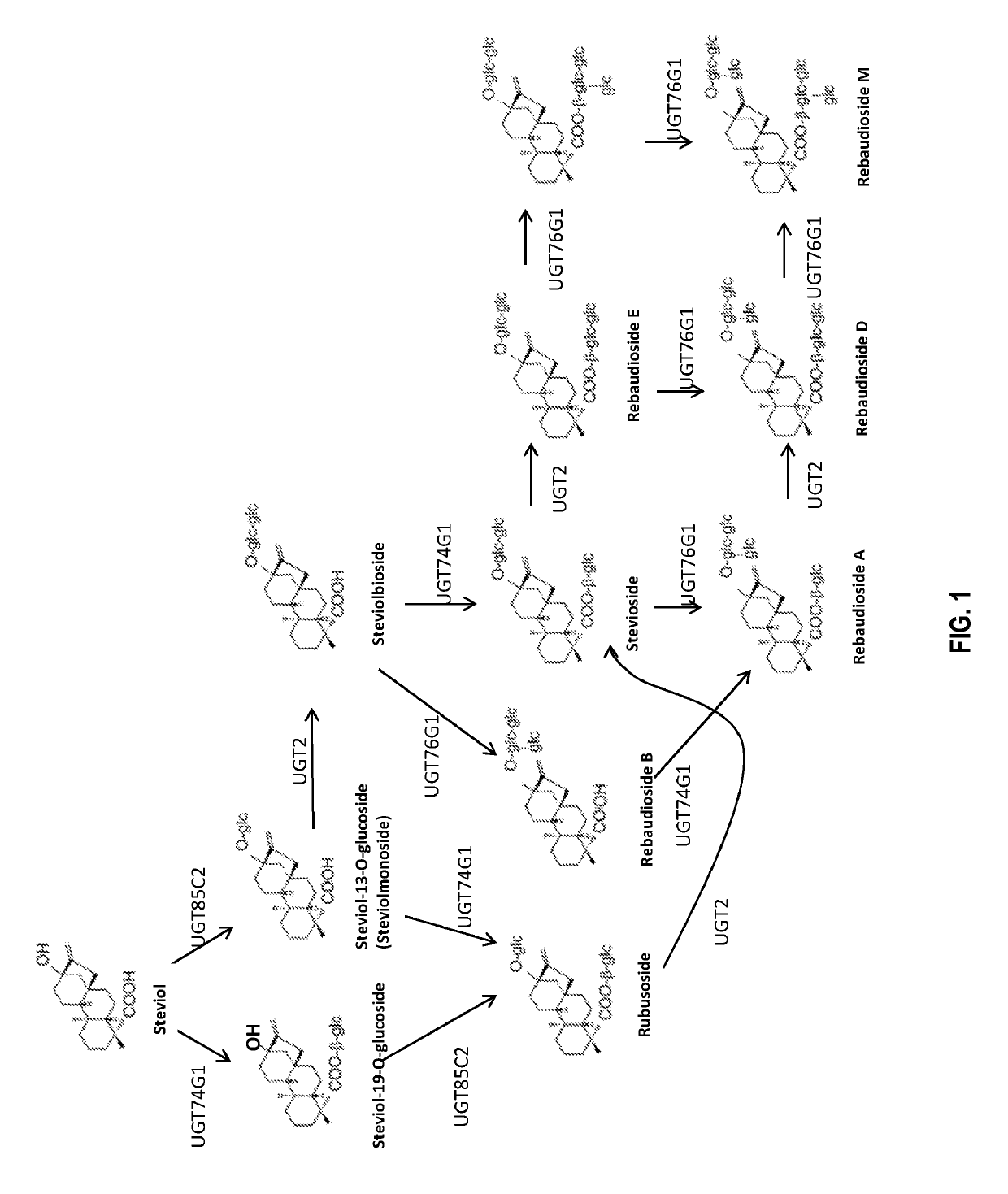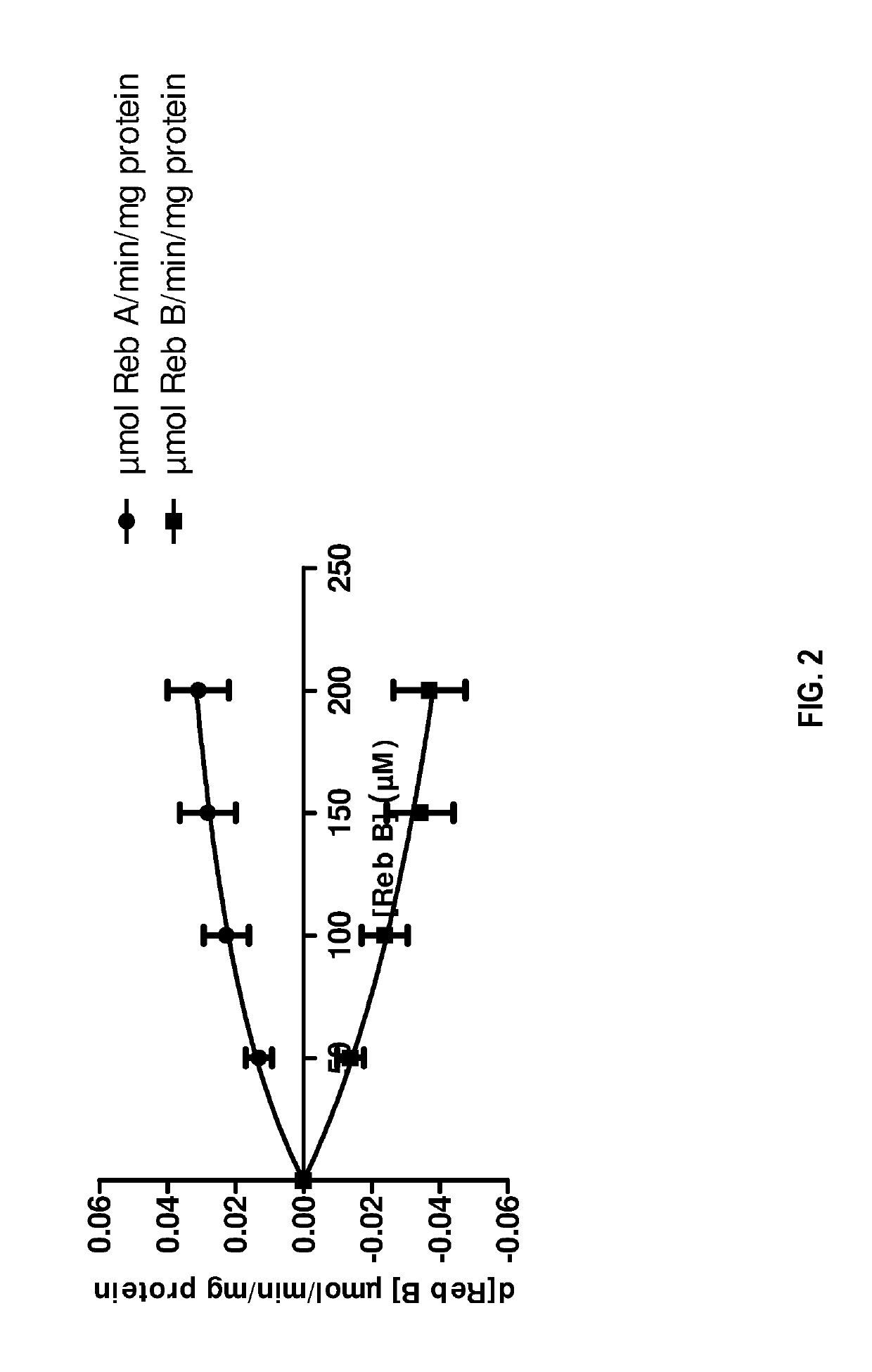Method for increasing glycosylation of a composition comprising steviol glycosides
- Summary
- Abstract
- Description
- Claims
- Application Information
AI Technical Summary
Benefits of technology
Problems solved by technology
Method used
Image
Examples
example 1
Use of Spent Biomass to Upgrade Steviol Glycoside Compositions
[0266]Experimental Set-Up[0267]Take fresh sample of best Yarrowia lipolitica or Saccharomyces cerevisiae strain cabable of production of rebA and / or rebD and / or RebM[0268]Ferment as set out in WO2013 / 110673 and WO2015 / 007748
[0269]Compare Different Methods for Conversion
[0270]Whole Cells[0271]wash harvested cells twice with ice cold physiological salt[0272]dilute to OD600=1
[0273]CFE[0274]wash harvested cells twice with ice cold physiological salt[0275]dilute to OD600=1[0276]add glass beads[0277]vortex rigorously 6×15″ with 1′ intervals (cooling) on ice[0278]spin down (10′ 5000 rpm) and wash pellet twice with 100 mM Tris-HCL, pH 7.5
Permeabilized cells (first wash harvested cells twice with ice cold physiological salt and dilute to OD600=1) (all steps at 4 C), one of several protocols may be used:[0279]15′ in 50% EtOH, wash twice with water, 15′ in 0.5% Triton X-100, spin down (5′ 3000 rpm) and wash pellet twice with 100 mM ...
example 2
Use of Spent Biomass to Glycosylate RebaudiosideB
[0294]Strains, Cultivation & Preparation
[0295]Yeast strains expressing constructs encoding the steviol glycoside production pathway as described WO2013 / 110673 and WO2015 / 007748 can be used. Here, yeast strains Saccharomyces cerevisiae (expressing UGT3-SEQ ID NO: 74) using constructs as described in WO2013 / 110673 and WO2015 / 007748) and Yarrowia lipolitica (as negative control) were grow o / n in YEPD medium. After determining the optical density at 600 nm (respectively 1.00×1010 cells / mL for this particular Saccharomyces cerevisiae cultivation and 7.50×109 cells / mL for this particular Yarrowia lipolitica cultivation), cells were lysed with 0.5 mm zirconia beads.
[0296]SMASHsay Protocol
[0297]The biomass was harvested by centrifugation (4000 rpm, 10 min, 4° C.) washed twice with PBS (phosphate buffered saline, Sigma Aldrich), 2×109-4×109 cells (concentration determined from optical density at 600 nm above) transferred to square welled 96-de...
example 3
Use of Spent Biomass to Glycosylate RebaudiosideA
[0309]Strains, Cultivation & Preparation
[0310]Methods to obtain yeast strains expressing constructs encoding the steviol glycoside production pathway are described in WO2013 / 110673 and WO2015 / 007748. Here, different Yarrowia lipolitica strains were used: the parent strain (as negative control) and strains expressing the whole steviol glycoside production pathway. Cells were grow o / n in YEPD medium. After determining the optical density at 600 nm (respectively 1.00×1010 cells / mL for the parent strain cultivation and 6.00-8.57×109 cells / mL for different Yarrowia lipolitica steviol glycoside producing strains), cells were lysed with 0.5 mm zirconia beads (see example 2 for details). The protein concentration of the thus obtained CFE were determined using Bradford reagent. The actual obtained protein concentrations ranged from 0,453 mg / mL to 0,771 mg / mL.
[0311]Bioconversion Set-Up
[0312]A dilution series of rebaudiosideA stock solutions was...
PUM
| Property | Measurement | Unit |
|---|---|---|
| Fraction | aaaaa | aaaaa |
| Fraction | aaaaa | aaaaa |
| Composition | aaaaa | aaaaa |
Abstract
Description
Claims
Application Information
 Login to View More
Login to View More - R&D
- Intellectual Property
- Life Sciences
- Materials
- Tech Scout
- Unparalleled Data Quality
- Higher Quality Content
- 60% Fewer Hallucinations
Browse by: Latest US Patents, China's latest patents, Technical Efficacy Thesaurus, Application Domain, Technology Topic, Popular Technical Reports.
© 2025 PatSnap. All rights reserved.Legal|Privacy policy|Modern Slavery Act Transparency Statement|Sitemap|About US| Contact US: help@patsnap.com



